A company employs a team of customer service agents to provide telephone and email support to customers.
The company develops a webchat bot to provide automated answers to common customer queries.
Which business benefit should the company expect as a result of creating the webchat bot solution?
Answer:
B
For a machine learning progress, how should you split data for training and evaluation?
Answer:
B
The Split Data module is particularly useful when you need to separate data into training and testing sets. Use the Split Rows option if you want to divide the data into two parts. You can specify the percentage of data to put in each split, but by default, the data is divided 50-50. You can also randomize the selection of rows in each group, and use stratified sampling.
Reference:
https://docs.microsoft.com/en-us/azure/machine-learning/studio-module-reference/split-data
HOTSPOT -
You are developing a model to predict events by using classification.
You have a confusion matrix for the model scored on test data as shown in the following exhibit.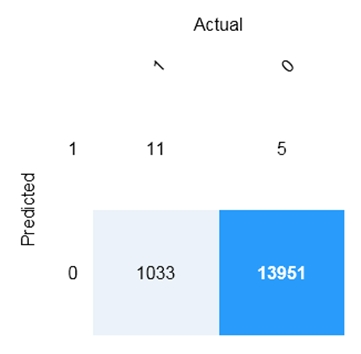
Use the drop-down menus to select the answer choice that completes each statement based on the information presented in the graphic.
NOTE: Each correct selection is worth one point.
Hot Area: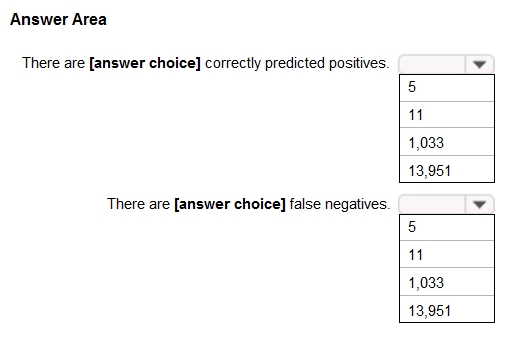
Answer:
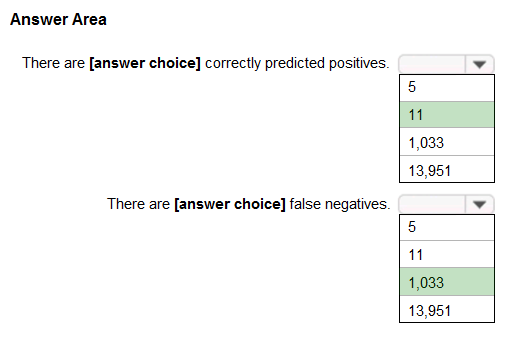
Box 1: 11 -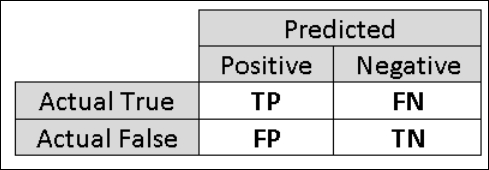
TP = True Positive.
The class labels in the training set can take on only two possible values, which we usually refer to as positive or negative. The positive and negative instances that a classifier predicts correctly are called true positives (TP) and true negatives (TN), respectively. Similarly, the incorrectly classified instances are called false positives (FP) and false negatives (FN).
Box 2: 1,033 -
FN = False Negative -
Reference:
https://docs.microsoft.com/en-us/azure/machine-learning/studio/evaluate-model-performance
You build a machine learning model by using the automated machine learning user interface (UI).
You need to ensure that the model meets the Microsoft transparency principle for responsible AI.
What should you do?
Answer:
B
Model Explain Ability.
Most businesses run on trust and being able to open the ML ג€black boxג€ helps build transparency and trust. In heavily regulated industries like healthcare and banking, it is critical to comply with regulations and best practices. One key aspect of this is understanding the relationship between input variables (features) and model output. Knowing both the magnitude and direction of the impact each feature (feature importance) has on the predicted value helps better understand and explain the model. With model explain ability, we enable you to understand feature importance as part of automated ML runs.
Reference:
https://azure.microsoft.com/en-us/blog/new-automated-machine-learning-capabilities-in-azure-machine-learning-service/
You use Azure Machine Learning designer to publish an inference pipeline.
Which two parameters should you use to access the web service? Each correct answer presents part of the solution.
NOTE: Each correct selection is worth one point.
Answer:
CD
You can consume a published pipeline in the Published pipelines page. Select a published pipeline and find the REST endpoint of it.
To consume the pipeline, you need:
✑ The REST endpoint for your service
✑ The Primary Key for your service
Reference:
https://docs.microsoft.com/en-in/learn/modules/create-regression-model-azure-machine-learning-designer/deploy-service
HOTSPOT -
To complete the sentence, select the appropriate option in the answer area.
Hot Area: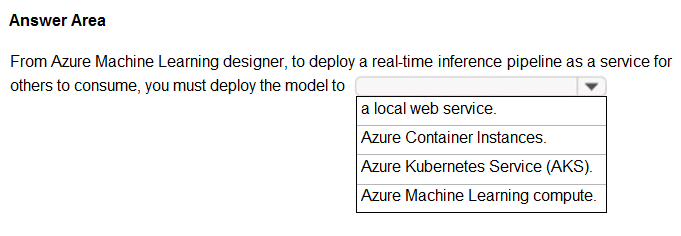
Answer:
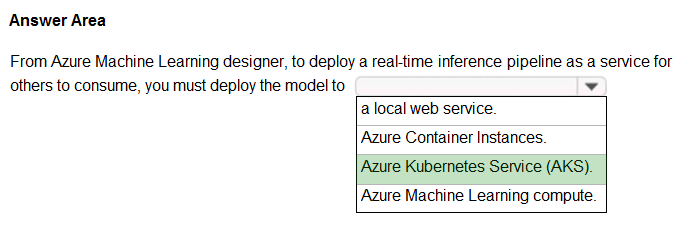
To perform real-time inferencing, you must deploy a pipeline as a real-time endpoint.
Real-time endpoints must be deployed to an Azure Kubernetes Service cluster.
Reference:
https://docs.microsoft.com/en-us/azure/machine-learning/concept-designer#deploy
HOTSPOT -
To complete the sentence, select the appropriate option in the answer area.
Hot Area: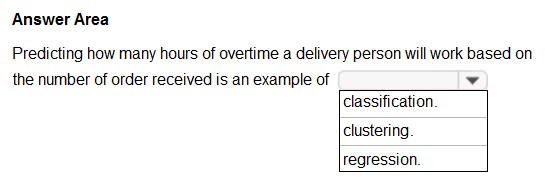
Answer:
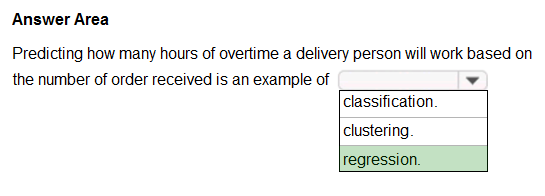
In the most basic sense, regression refers to prediction of a numeric target.
Linear regression attempts to establish a linear relationship between one or more independent variables and a numeric outcome, or dependent variable.
You use this module to define a linear regression method, and then train a model using a labeled dataset. The trained model can then be used to make predictions.
Incorrect Answers:
✑ Classification is a machine learning method that uses data to determine the category, type, or class of an item or row of data.
✑ Clustering, in machine learning, is a method of grouping data points into similar clusters. It is also called segmentation.
Over the years, many clustering algorithms have been developed. Almost all clustering algorithms use the features of individual items to find similar items. For example, you might apply clustering to find similar people by demographics. You might use clustering with text analysis to group sentences with similar topics or sentiment.
Reference:
https://docs.microsoft.com/en-us/azure/machine-learning/algorithm-module-reference/linear-regression https://docs.microsoft.com/en-us/azure/machine-learning/studio-module-reference/machine-learning-initialize-model-clustering
HOTSPOT -
For each of the following statements, select Yes if the statement is true. Otherwise, select No.
NOTE: Each correct selection is worth one point.
Hot Area: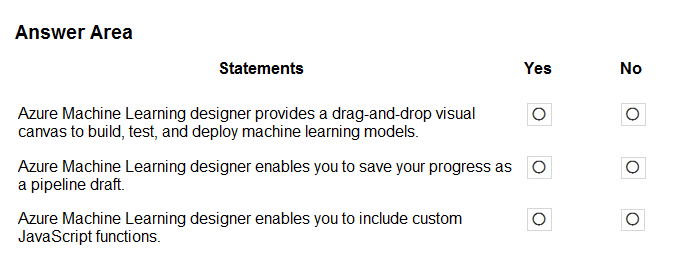
Answer:
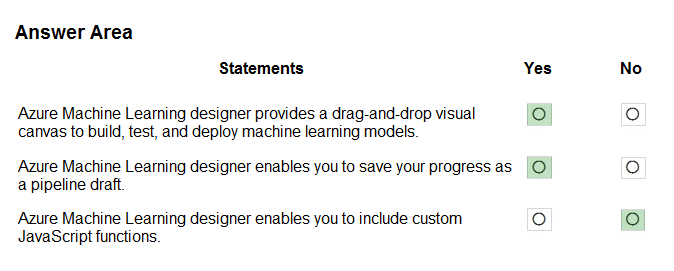
Box 1: Yes -
Azure Machine Learning designer lets you visually connect datasets and modules on an interactive canvas to create machine learning models.
Box 2: Yes -
With the designer you can connect the modules to create a pipeline draft.
As you edit a pipeline in the designer, your progress is saved as a pipeline draft.
Box 3: No -
Reference:
https://docs.microsoft.com/en-us/azure/machine-learning/concept-designer
HOTSPOT -
You have the following dataset.
You plan to use the dataset to train a model that will predict the house price categories of houses.
What are Household Income and House Price Category? To answer, select the appropriate option in the answer area.
NOTE: Each correct selection is worth one point.
Hot Area: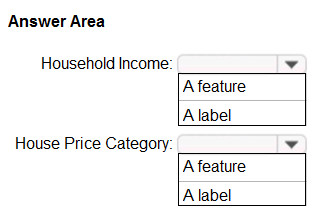
Answer:
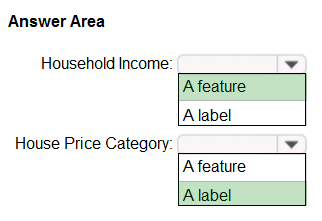
Reference:
https://docs.microsoft.com/en-us/azure/machine-learning/studio/interpret-model-results
HOTSPOT -
To complete the sentence, select the appropriate option in the answer area.
Hot Area: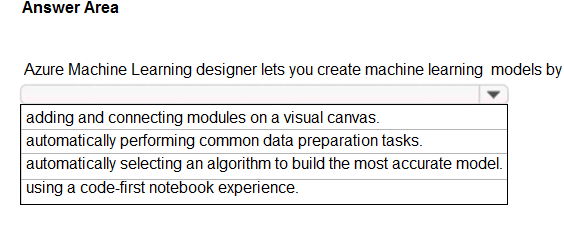
Answer:
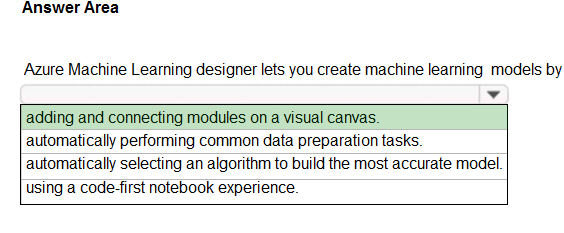
Reference:
https://docs.microsoft.com/en-us/azure/machine-learning/concept-designer